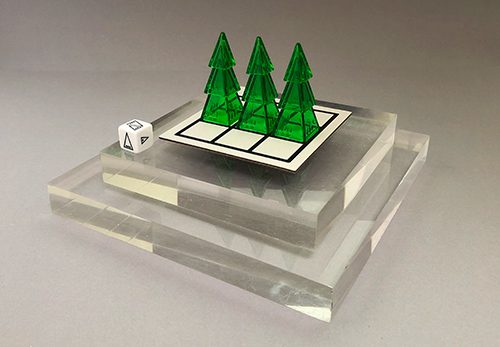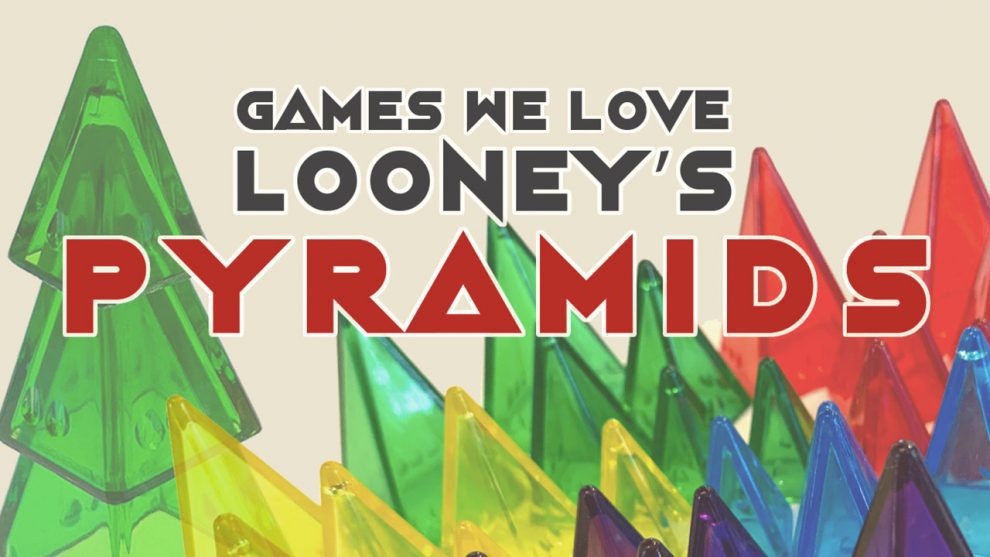If you read my review of all 22 games in Looney Labs’ Pyramid Arcade, you hopefully got the impression that I’m a big fan of both the game and the Pyramids themselves. This isn’t a recent occurrence — rather, it’s been an admiration that started long before I ever saw a set of the Pyramids.
Let me explain.
I first learned about Andy Looney’s pyramid pieces decades ago when I read the snippet of a short story that he wrote. In that story, he described people playing a game called Icehouse. The game was played with colored pyramids on the floor of a subway station and progressed without specific turns. Intrigued, I asked around for more information on Icehouse, but in those pre-Internet days, I came up with nothing.
A Brief History of the Pyramids

As it turned out, I wasn’t the only person who was curious about the Icehouse game. Many of Looney’s friends wanted to know more about the pyramids and, more specifically, how to play the game. Andy’s lifelong friend, John Cooper, came to Looney’s rescue by devising rules for the original Icehouse game. Looney’s NASA co-worker Kristin Wunderlich then convinced him to start a company to publish the game.
Icehouse pieces were originally solid, elongated pyramids handmade of resin in Looney’s apartment — an awkward, smelly process that almost got him kicked out of the apartment by his landlord.
The Icehouse pyramids, while appearing in Large, Medium, and Small sizes, were still solid pieces. Icehouse sets were all handmade and achieved something of a cult status, but were clearly not going to be the base of a sustainable business.
Kristin (by then Andy’s wife) knew they needed a different kind of game for their fledgling business, one that was considerably easier and cheaper to produce. She challenged Andy to come up with a new and different type of card game. The resulting game is one you might have heard of: Fluxx.
Introduced in 1997, the original version of Fluxx was a Mensa Select Winner in 1999. Since then, there are over 20 different varieties (or “flavors” as Looney Labs calls them) of the games, ranging from Cthulhu Fluxx to Monty Python Fluxx to Doctor Who Fluxx to Nature, Chemistry, and Anatomy Fluxxes.
The first Fluxx game I played was Zombie Fluxx. Abstract purist that I am, I was fully prepared to be completely unimpressed by yet another card game that tried to pretend that players could exert any semblance of control over the predetermined outcome of a deck of cards. Within minutes, though, the winning conditions had changed more than once and everyone had been forced to pass all of their cards to the person to their side, I had to admit how wrong I was.
See, I also fully embrace that side of my gaming proclivities that (even I don’t fully understand, yet) embraces just the right combination of elements that I typically disdain and contorts them with just the right touch of absurdity. I know people who don’t like Fluxx because the rules constantly change. I, on the other hand, feel Fluxx is the perfect card game because those constantly changing rules embrace the otherwise pointless (to my mind) drawing and playing of cards. For me, Fluxx strikes that perfect balance of preposterousness and capricious instability that I truly admire.
With the financial success Fluxx brought the Looneys they were able to rethink the Icehouse pyramids and, more importantly, redesign them. Renamed the Looney Pyramids, the once solid pyramids became hollow and, therefore, stackable.
Suddenly, new imaginative game designs started flowing.
Initial Thoughts: More Than Just Pretty Pyramids
If you just glance at the photos and skim through some of the games I write about in my review of Pyramid Arcade one thing is clear: the Pyramids are not just pieces, but components to a unique gaming system.
The Pyramids represent potentials, just as the individual cards in a deck of cards do — but, unlike cards, their potentials exist in a three-dimensional game design universe.

The games in Pyramid Arcade were chosen to represent a cross-section of the myriad types of games the Pyramids lend themselves to. Need a game for kids? There are plenty of them there. Want to use the Pyramids as a gateway game to interest newcomers to the gaming hobby? Not a problem. Want a few brain-burners to challenge the diehard Abstract fans like myself? Step right this way…
And while not every game will be for every type of gamer, there will undoubtedly be some that catch your imagination. Developing an appreciation for even just a few of these games will likely extend your willingness to try some of the other games in the Arcade. They can be surprisingly addictive — in a good way.
Designing Your Own Games
That cult gaming status of the early Icehouse sets grew exponentially once the Internet became a common arena for people to find others with their niche interests. Pyramid lovers began sharing games they had created and collecting them for others to test play and share. Take a look at IcehouseGames.org and you’ll find the rules for over 500 games using the Looney Pyramids as well as strategy discussion areas for the more complex games.
Reading through the games that other people have created around these stackable Pyramids you might find your own game design thoughts flowing. The Starship Captains group on Facebook is a great place to discuss pyramid games and game designs.
One of the beauties of the Pyramid gaming system is that the games can be as simple or as complex as you want them to be. If you have some bored kids at home, give them the Pyramid Arcade without the rule book and tell them to come up with a game the family can play later that night. You’ll probably be surprised at what they come up with!

Final Thoughts
There is something both simple and familiar about the Looney Pyramids. What could be intimidating about a series of hollow, 3D triangles that can either be stacked on top of one another to form a tree-like design or hide inside one another like a Russian nesting doll?
For me, it was that combination of approachability mixed with games that did away with the requirement of a confined playing area (i.e., a board) that drew me to the Pyramids. Being able to take some basic concepts and then turning them on their head, forcing me to think of them in completely different ways is something I both admire and respect in designers.
I don’t think I’m alone in that appreciation. My guess is that those same elements that earned my appreciation and captured my imagination did the same for the many game players who bought the first Icehouse sets and then, years later, were some of the over 2,000 people who backed the Kickstarter campaign that launched the Pyramid Arcade in 2016.
If you’ve never played with the Looney Pyramids before, I hope between this appreciation and my review of Pyramid Arcade have convinced you to seek them out. With over 500 games to explore, you’re sure to find some games that you’ll not only want to play, but teach to your friends as well.
Then, think of it this way: being small and portable, the Pyramids are like the mental equivalent of the Hacky Sack from the ‘80s and ‘90s: easy to start playing, intriguing to watch, and fun enough to have others want to join in.
Postscript
I grew up in the same county in Maryland where Looney Labs started — heck I even earned two degrees from the University of Maryland, College Park, the same town where their company is headquartered. Andy and I are almost the same age. I worked in a CD store just a few miles down the road from where Andy and Kristin met when they were working for NASA. Despite all of this proximity and our mutual love for games, I never met either of them. One day I’ll have to have a long talk with The Fates about this and find out why.











I agree with what you say. Read my post about the Pyramids at https://english2classroom.blogspot.com/2021/05/what-is-your-favourite-board-game-to.html